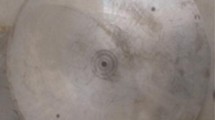Abstract
Tool wear has an important influence on machining quality, cost, cutting force and heat. Grooving blisk with disc milling cutter is 3–4 times more efficient than plunge milling and side milling, but the tool wear is serious because of the large milling force and high milling temperature during the machining process. In the study, the damage and wear morphology of the tool was observed by focused ion/double beam system; the wear mechanism was studied by energy spectrum analysis; the tool life curve was drawn by the increase of flank wear. The experimental results show that the main wear and damage morphologies of disc milling cutter are chip sticking to the tool, chip accumulation, edge collapse, peeling, crack, plastic deformation and boundary wear; the main wear mechanism are abrasive wear, adhesive wear, oxidation wear and diffusion wear; the wear rate of the left blade is the fastest, followed by the right blade, and the wear rate of the middle blade is the slowest. These results can provide guidance for iimproving tool life, optimizing tool and mproving machining processes.
Similar content being viewed by others
References
Z. Y. Xu and Y. D. Wang, Electrochemical machining of complex components of aero-engines: developments, trends, and technological advances, Chinese Journal of Aeronautics, 34(2) (2021) 28–53.
Z. Y. Xu, Q. Xu and D. Zhu, A high efficiency electrochemical machining method of blisk channels, CIRP Annals, 62(1) (2013) 187–190.
Y. Z. Fu, H. Gao and X. P. Wang, Machining the integral impeller and blisk of aero-engines: a review of surface finishing and strengthening technologies, Chinese Journal of Mechanical Engineering, 30 (2017) 528–543.
W. Y. Ming, Z. B. Xie and J. Ma, Critical review on sustainable techniques in electrical discharge machining, Journal of Manufacturing Processes, 72 (2021) 375–399.
X. C. Zhang, Y. K. Zhang and J. Z. Lu, Improvement of fatigue life of Ti-6Al-4V alloy by laser shock peening, Materials Science and Engineering: A, 527(15) (2010) 3411–3415.
K. Ishfaq, N. A. Mufti and N. Ahmed, An investigation of surface roughness and parametric optimization during wire electric discharge machining of cladded material, The International Journal of Advanced Manufacturing Technology, 97(9) (2018) 4065–4079.
H. M. Xin, Y. Y. Shi and H. W. Wu, Tool wear in disc milling grooving of aircraft engine blisk, Iranian Journal of Science and Technology, Transactions of Mechanical Engineering, 45 (2021) 555–566.
N. Zhang and Y. Y. Shi, A 3-D instantaneous cutting force prediction model of indexable disc milling cutter for manufacturing blisk-tunnels considering run-out, The International Journal of Advanced Manufacturing Technology, 103 (2019) 4029–4039.
N. Zhang, Y. Y. Shi and C. Yang, An instantaneous cutting force model for disc mill cutter based on the machining blisk-tunnel of aero-engine, The International Journal of Advanced Manufacturing Technology, 99 (2018) 233–246.
C. Xian, Y. Y. Shi and J. Luo, Milling force modeling for disc milling cutter of indexable three-sided inserts considering tool runout, The International Journal of Advanced Manufacturing Technology, 115 (2021) 2191–2204.
C. Yang, Y. Y. Shi and H. M. Xin, Milling force model prediction considering tool runout with three-teeth alternating disc cutter, The International Journal of Advanced Manufacturing Technology, 114 (2021) 3285–3299.
H. L. Dong, H. M. Xin and Y. Y. Shi, Design on multi-milling machine of blisk, Mach. Des. Manuf., 5 (2014) 11–13.
M. Jamil, N. He and M. K. Gupta, Tool wear mechanisms and its influence on machining tribology of face milled titanium alloy under sustainable hybrid lubri-cooling, Tribology International, 170 (2022) 1–18.
Y. Li, W. J. Tian, J. X. Ren, J. F. Yao and Y. F. Zhang, Experimental study on wear of GH4169 superalloy insert milling tools cooled at low temperature, Modern Manufacturing Engineering (8) (2017) 87–92.
Z. Y. Wang, Y. D. Liang and H. Y. Li, Milling force and tool wear mechanisms on milling TC21 titanium alloy under different lubrication conditions, The International Journal of Advanced Manufacturing Technology, 123 (2022) 169–185.
J. Y. Ma, D. C. Luo and X. P. Liao, Tool wear mechanism and prediction in milling TC18 titanium alloy using deep learning, Measurement, 173 (2021) 1–13.
T. X. Yang, Research on tool wear and optimization of cutting edge structure during insert milling of 0Cr13 stainless steel, Master’s Thesis, Harbin University of Technology (2018).
T. Sun, Y. C. Fu and L. He, Machinability of plunge milling for damage-tolerant titanium alloy TC21, The International Journal of Advanced Manufacturing Technology, 85(5) (2016) 1315–1323.
Y. N. Cheng, J. L. Yang and T. Q. Chen, Design and wear analysis of tool for high-efficiency disk milling roughing of aeroengine blisk channels, The International Journal of Advanced Manufacturing Technology, 96(1) (2018) 1305–1317.
H. M. Xin, Y. Y. Shi and L. Q. Ning, Tool wear in disc milling grooving of titanium alloy, Advanced in Mechanical Engineering, 8(10) (2016) 1–11.
Acknowledgments
This work was supported by the National Numerical Control Major Projects Foundation of China (Grant No. 2013ZX0400 1081); Hubei Superior and Distinctive Discipline Group of “Mechatronics and Automobiles”; Hubei Superior and Distinctive Discipline Group of “New Energy Vehicle and Smart Transportation”; Hubei Longzhong Laboratory, Xiangyang 441000, Hubei, China; Science and technology project of Xiangyang City (Grant No. 2021AAHO03594).
Author information
Authors and Affiliations
Corresponding author
Additional information
Xin Hongmin is a Postdoctoral Fellow in Aerospace Manufacturing Engineering of Northwestern Polytechnical University of China. She received her doctorate in mechanical engineering from Northwestern Polytechnical University. Her research interests are numerical control intelligent equipment and process technology for aviation complex curved surface structures, Internet of Things and intelligent transportation technology.
Rights and permissions
About this article
Cite this article
Cheng, Q., Wang, S., Xin, H. et al. Study on tool wear for efficient grooving blisk with disc milling cutter. J Mech Sci Technol 37, 5335–5348 (2023). https://doi.org/10.1007/s12206-023-0935-2
Received:
Revised:
Accepted:
Published:
Issue Date:
DOI: https://doi.org/10.1007/s12206-023-0935-2




